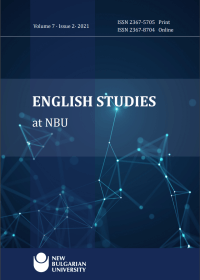Implicit Arguments in Ugandan English
DOI:
https://doi.org/10.33919/esnbu.21.2.2Abstract
In standard British/American English, some transitive verbs, which are ontologically specified for objects, may be used with the objects not overtly expressed (for example, leave), while other transitive verbs do not permit this syntactic behavior (for example, vacate). The former have been referred to as verbs that allow implicit arguments. This study shows that while verbs such as vacate do not ideally allow implicit arguments in standard British/American English, this is permitted in Ugandan English (a non-native variety), thereby highlighting structural asymmetries between British/American English and Ugandan English, owing mainly to substrate influence and analogization. The current study highlights those structural asymmetries and ultimately uncovers some characteristic features in the structural nativization process of English in Uganda, thereby contributing to the growing larger discourse meant to fill the gaps that had characterized World Englishes scholarship, where thorough delineations of Ugandan English have been virtually absent.
Downloads
Published
How to Cite
Issue
Section
License
All published articles in the ESNBU are licensed under the Creative Commons Attribution-NonCommercial 4.0 International License (CC BY-NC 4.0). This license lets others remix, tweak, and build upon your work non-commercially, and although their new works must also acknowledge you and be non-commercial, they don't have to license their derivative works on the same terms.
In other words, under the CC BY-NC 4.0 license users are free to:
Share - copy and redistribute the material in any medium or format
Adapt - remix, transform, and build upon the material
Under the following terms:
 Attribution (by) - All CC licenses require that others who use your work in any way must give you credit the way you request, but not in a way that suggests you endorse them or their use. If they want to use your work without giving you credit or for endorsement purposes, they must get your permission first.
Attribution (by) - All CC licenses require that others who use your work in any way must give you credit the way you request, but not in a way that suggests you endorse them or their use. If they want to use your work without giving you credit or for endorsement purposes, they must get your permission first. NonCommercial (nc) - You let others copy, distribute, display, perform, and modify and use your work for any purpose other than commercially unless they get your permission first.
NonCommercial (nc) - You let others copy, distribute, display, perform, and modify and use your work for any purpose other than commercially unless they get your permission first.
If the article is to be used for commercial purposes, we suggest authors be contacted by email.
If the law requires that the article be published in the public domain, authors will notify ESNBU at the time of submission, and in such cases the article shall be released under the Creative Commons 1 Public Domain Dedication waiver CC0 1.0 Universal.
Copyright
Copyright for articles published in ESNBU are retained by the authors, with first publication rights granted to the journal. Authors retain full publishing rights and are encouraged to upload their work to institutional repositories, social academic networking sites, etc. ESNBU is not responsible for subsequent uses of the work. It is the author's responsibility to bring an infringement action if so desired by the author.
Exceptions to copyright policy
Occasionally ESNBU may co-publish articles jointly with other publishers, and different licensing conditions may then apply.






